What remains of the Manhattan Project? A lot of documents. Some people. A few places. And a handful of artifacts. Maybe less than one might expect, maybe more than one might expect — it was a very large, expensive undertaking, involving a lot of people, so there being some remnants is not surprising. Though given its size, and importance, perhaps one would expect more.
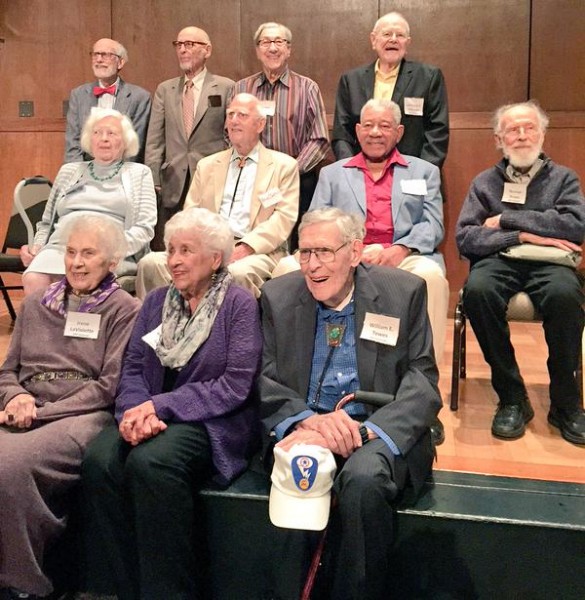
Some of the attending Manhattan Project veterans. Photo by Alex Levy of the Atomic Heritage Foundation.
The symposium put on by the Atomic Heritage Foundation last week was really excellent — a really important event. The attendance was higher than I would have guessed. At least a dozen Manhattan Project veterans attended, and many children of Manhattan Project veterans (some of whom were born during the war) were there as well. There were also a lot of nuclear historians, scientists, and enthusiasts. I got to spend time talking with a lot of wonderful people who also cared a lot about, and took very seriously, the history of the atomic bomb. Among those who were there included Richard Rhodes (Pulitzer-winning author of The Making of the Atomic Bomb), Stan Norris (biographer of Leslie Groves), Kai Bird and Martin Sherwin (Pulitzer-winning authors of American Prometheus), John Coster-Mullen (major irritant to government censors and author of Atom Bombs), Avner Cohen (author of many books on Israel and the bomb), Ray Smith (the historian at Y-12), and Clay Perkins (physicist and nuclear “collector”), just to name a few. I saw some of my DC friends and former colleagues, and met a lot of nuclear history enthusiasts. All together, it looked like there was well over two hundred people between the two days of it.
There were several themes to the whole event. One was the creation of the Manhattan Project National Historic Park. There were representatives from both the National Park Service and the Department of Energy to talk about the process going forward, and there was also an excellent address by Senator Martin Heinrich of New Mexico.
Richard Rhodes gave the first address of Wednesday by talking about why we save authentic relics of the past. He took a tack I wouldn’t have expected — he started off from the work of the philosopher John Searle on “social reality,” the sorts of facts that exist only by mutual agreement. “When we lose parts of our physical past, we lose part of our social past as well.” Our preference for the originals of things, the “authentic” objects, isn’t just about sentiment, he argued — it is part of what defines us. (And if you don’t believe physical things define you, try losing a wedding ring, or an irreplaceable album of old photographs.) Preserving public memories, spaces of our past, whether positive or negative, help us come to terms with who we are, and what we have done. And he made the point, quite effectively, that we do not just preserve the sites that glorify us — Ford’s Theatre, Manzanar, and the Sand Creek massacre site are all National Historic Sites as well.

Battle deaths in state-based conflicts, 1946-2013, by Max Roser. This is what Rhodes had in mind regarding the decreased amount of deaths from war since World War II. (Note that WWII’s rate of battle deaths was around 300 per 100,000.) There are a lot of ways to parse these numbers, as Roser’s site makes clear (the raw numbers of wars has been increasing, some of this decline as a unit of population is due to the massive increase in global population), and there are multiple interpretations of the data (whether the bomb has anything to do with it is disputed by scholars), but it is still very interesting. Source: Max Roser, “War and Peace after 1945,” OurWorldInData.org.
Rhodes is no fan of nuclear weapons, and doesn’t believe that the atomic bombs were what caused Japan to surrender in World War II. 1 Yet, he argued that when J. Robert Oppenheimer told his recruits that these weapons might end all war, he might not have been wrong. Rhodes noted the marked decrease of deaths by war in the years that followed World War II, paired with the increased risk of a terrible nuclear holocaust. Nuclear weapons, he argued, were the first instance in which science revealed a natural limit to national sovereignty. In Rhodes framing of it, scientists found facts of the natural world which required new political interventions and methods to avoid certain types of war.
As a result, he said, these Manhattan Project sites were potentially among the most significant in the history of the world. It was an interesting way to start things off.
In an event where the participants are present, it is easy to fall into something that feels like just a celebration. And there were those, without a doubt, who felt positively about the Manhattan Project, that it was necessary to end the war, and all of that. There were also those who thought it wasn’t necessary, too. I think my favorite comment came from James Forde, a Manhattan Project veteran who had been employed to clean tubes (later revealed to be gaseous diffusion barriers) near Columbia University during the war. He said that for awhile he felt bad about the atomic bombs, but then he looked more into all of the other damage that non-atomic weapons had done during the war. After that, he lost any enthusiasm for war of any kind. He got solid applause for that.
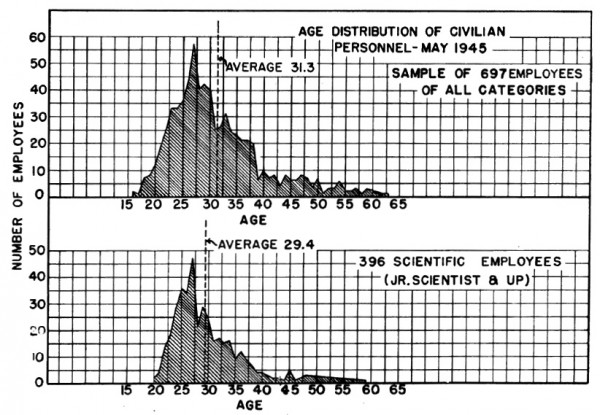
Age distribution at Los Alamos, May 1945. Top graph is total civilian personnel, bottom is scientific employees only. Keep in mind this was 70 years ago, so anyone in their 20s then would be in their 90s now. Source: Manhattan District History, Book 8, Volume 2, Appendix, Graph 1.
The veterans who were there had all been extremely young at the time. This makes sense, of course — if it is the 70th anniversary, almost nobody older than their early twenties is going to still be around today. And at many of the sites, the youth were in abundance. As a result, most of them had fairly small roles, small jobs, though some of them had rubbed shoulders with the giants. There were a few remarkable anecdotes. Isabella Karle talked about working as a chemist at the Metallurgical Laboratory in Chicago, working on plutonium oxide produced at the Oak Ridge X-10 reactor. She had to move it between buildings, and since it was such a small amount, she just carried it in her pocket. Someone found out she was doing this, and required her, a young woman with pigtails, to be escorted between building by burly guards, attracting more attention than she would have otherwise. She also related a story about carrying a radiation counter around with her, and having it go off next to a Coca-Cola machine. Apparently a deliveryman had forgotten some tubing in his car, and borrow a contaminated tube from a Met Lab office, contaminating the machine with who knows what. Fortunately, she said, she had stumbled across this before anyone had used it.
Ben Bederson told some amazing stories about David Greenglass, who he had bunked with as a member of the Special Engineer Detachment. Greenglass, he said, was a “true believer” of a Communist. Bederson pointed out that he, like many New York Jews at the time, had been interested in Communism for awhile (he had grown up in a part of the Bronx that was considered a “Communist neighborhood”) but that most had become disillusioned with it by the time the US was in the war. Greenglass never seemed to take the hint, though, and thought Bederson was a fellow traveler. It was an amusing contrast to people like Klaus Fuchs and Ted Hall, who hid their politics. Bederson eventually asked to be transferred to a different bunk. Later, Greenglass told the FBI he had wanted to try and recruit Bederson but his courier, Harry Gold, told him not to. The reason Greenglass thought Bederson would be a good recruit is because he gave money to the Roosevelt reelection campaign. “That shows you how smart David Greenglass was,” Bederson remarked with sarcasm.
Along with the veterans and the historians, there were some artifactual pieces of the past there. Clay Perkins had brought the arming switches of the Little Boy bomb, which he purchased over a decade ago. The green (“safe”) one was kept plugged into the bomb until after takeoff. While in flight, the assistant weaponeer, Morris Jeppson, climbed into the unpressurized bomb bay of the Enola Gay and removed it. In its place, he put a red (“armed”) plug, making the bomb electrically “live.” (The red plug that Clay has is a spare, of course — the original was destroyed in the explosion over Hiroshima. Jeppson brought multiple spares with him since if he had dropped one during the operation, it would have aborted the mission.) Clay let me hold them, which was moving.
There was also a very surprising artifact brought by one of the veterans: a lucite hemisphere with pieces of Trinitite embedded in it. The Trinitite is not so rare, but the lucite was cast in the same mold that made the plutonium pits for the Trinity and Fat Man bombs, and included the small hold for the neutron initiator. This is an incredible thing to have kept (and I was also allowed to hold this, as well). I am sure its existence is the result of a violation of untold numbers of security rules. John Coster-Mullen, as I expected would, came up immediately afterwards to trace the dimensions. It looked how we all expected it to, but it still amazing to see something like this, knowing how secret it once was, and even now is supposed to be. 2
I knew the plugs existed, I did not know the lucite existed. There is something profound about holding artifacts that had such strong connections to history. That historical empathy I spoke of in my most recent post has something to do with it — the brain suddenly makes this connection with this world that often seems so far away. But of course it really isn’t that far away, and the world we have today is largely a product of it. But sometimes even historians need reminders.
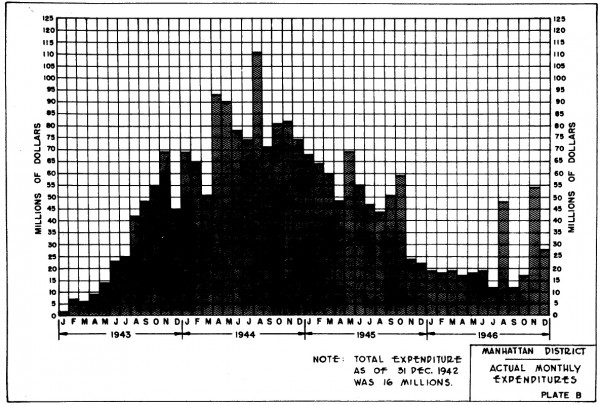
Monthly costs of the Manhattan Project, 1943 through 1946. From the Manhattan District History, Volume 5, Appendix A.
My own contribution to the symposium was a talk about the Manhattan Project as a “Crucible for Innovation.” I didn’t choose the title (it is not really my style, even though I do teach at “The Innovation University“), but it was easy enough to roll with: how much innovation took place during the Manhattan Project, and why was it successful? I talked a bit about the secret Manhattan Project patent program as one way to measure its innovation. By the time the AEC took over, the Manhattan Project patent program approved 2,100 separate secret patent applications for filing, and had already filed 1,250 of them with the US Patent Office. As I noted in an article from a few years ago, that latter number represented 1.5% of all of the patent applications filed in 1946. The Manhattan Project was not just the building of a bomb, but the creation an entirely new industry from scratch.
Why did the Manhattan Project succeed? Well, I argued, it almost didn’t — all you would need for it to have been a “failure” (in the sense of having not produced atomic bombs by the end of World War II) would to have been delayed by likely a few months. Which anyone who has ever tried to run even a small project knows is easy enough to do. I always try to emphasize this lack of an inevitability when I talk about the wartime effort, because it is easy to fall into the fallacy of knowing how the story ends and thus seeing it as predestined. The Manhattan Project was an anomaly: it was not innovation as usual, and it was not the natural or obvious path to take. Which is one reason why the US was the only country who actually went down that path with any seriousness during the war. The Manhattan Project still holds the world record for fastest tested or deliverable nuclear weapon after committing to build one: two and a half years. 3
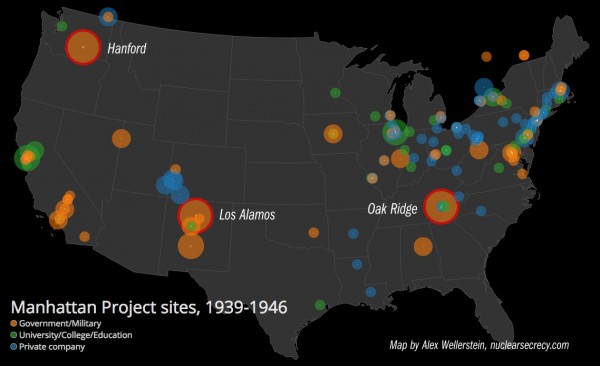
A preview of my forthcoming Manhattan Project sites map. Size is a subjective “prominence” rating given by me, the white dots show the actual location of the sites, and the color corresponds to whether it is government/military, educational institution, or private industry. An interactive version will be unveiled this summer, which will give more information about specific sites and permit zooming in, and etc. This only shows sites in the continental US and lower Canada — there are other non-US sites as well in the final version.
Lastly, I also emphasized the size of the project. I’ve talked on here about the immense cost of the work, and the greater-than-most-people-realize manpower requirements. But I also unveiled a screenshot of a work in progress. For a while now, I’ve been trying to make a database of every site where some sort of work on the Manhattan Project was done. I’ve been combing through the Manhattan District History, through archival files on contracts, and through databases of radioactive Superfund sites. I’ve been keeping a tally of any places listed as having some role in the final outcome, however minor. My current list is well over 200 separate sites. Some of these places were research institutions (about 40 are educational institutions of some nature), some were military or government institutions (some created from scratch, some pre-existing), and about half were private industry. Some places produced materials, some just produced paper. (The symposium took place in the Carnegie Institute of Science, which was where Vannevar Bush’s Office of Scientific Research and Development headquarters were during the war, and I delighted in getting to point this out.) Not all sites were equally important, to be sure. But all played some role, even if most of those places probably did not actually know what their role was. The screenshot above is a preview of the map — it is still a work in progress, and the final version will be fully interactive, sortable into different categories, and so on.
It’s a big list. Bigger than I thought when I started it. It just emphasizes again that the Manhattan Project was responsible for the birth of an industry, not just the bomb. Upon learning about the scale of the project in 1944, Niels Bohr told Edward Teller: “I told you it couldn’t be done without turning the whole country into a factory. You have done just that.” It was an apt observation.
Very little of this infrastructure remains. The Manhattan Project National Historic Park is an important step in the right direction for preservation of this history. There is a long road yet to go in terms of figuring out how to make it available to the public, and how to properly present the material. I remain optimistic that it will be an opportunity to talk about history in a productive way, and to build bridges between the ever-changing present and the ever-receding past.
- Rhodes is explicitly convinced by the Hasegawa thesis. In his words, though, “I find tragedy but no dishonor in having used atomic bombs to hasten the end of the war,” whether they actually hastened that end or not. It is a nuanced point to make.[↩]
- John says it is a bit smaller than the actual pit — the initiator would not have been able to fit in the hole given, and the mass would be off by a few percentage points. So either it was cast in an earlier or alternative pit model, or something happened to it in the meantime. My hypothesis is that it was cast in the actual pit mold, but that it shrunk in some way over time, either because it contracted while it cooled originally (the thermal contraction coefficient for acrylic is around 5X that of uranium, just as a point of comparison), or through some other warping mechanism over the last 70 years.[↩]
- The decision to produce nuclear weapons was made in December 1942. The work prior to this was of an exploratory or pilot nature, not a production program. The “Gadget” was ready by mid-July 1945, the other bombs were ready by the end of the month.[↩]
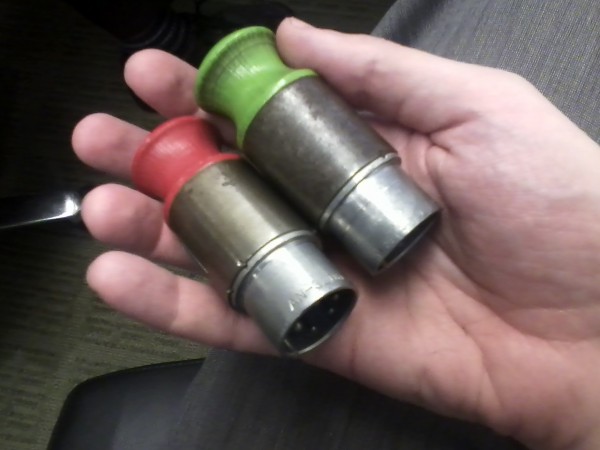


The Atomic Heritage Foundation page on the event offers hopeful news: “Video of the event will be online soon on our website and with C-SPAN.” For those of us who did not attend, something to anticipate.
Thanks Bill — I was going to mention something about that and forgot.
I decided I couldn’t pass up the opportunity, and flew to DC from California for the reunion/symposium. I was able to meet Ben Bederson and talk to him face-to-face (he was my dad’s bunk-mate on Tinian), and while I had talked with Ben via email a couple of times, I had never met or heard of Robert JS Smith, who also worked under Don Hornig on the electronics of the triggering device with my dad. It was great to see his face light up when I mentioned my dad’s name! I’m sorry I didn’t have a chance to talk to you, Alex, or John Coster-Mullin, as I have followed and enjoyed your work for several years now. It was an amazing and important event indeed, and I’m very, very glad that I attended.
It was and honor and pleasure to spend time with you! Your own talk was amazing and illustrates your immense enthusiasm for this most alluring of topics. Unfortunately, as I also mentioned to you earlier, once bitten by the “nuke” bug, the infection spreads rapidly and soon takes over your entire body. I’ve had that infection since early grade school back in the Stone Age and there is no cure!
On that graph of monthly costs, what are the two spikes in the second half of 1946?
I’m not entirely sure. In July 1946 the Military Appropriations Act passed, giving the Manhattan Engineer District a fairly hefty sum ($72.4 million) to improve existing installations and to build a few more ones (including what would become Brookhaven National Laboratory). I suspect this accounts for some of these spikes, but I don’t know for sure.
Well, B Reactor is still more or less intact, we do tours of it from time to time, if I can believe what I read it not only produced the Pu for Trinity and Fat Man, it also produced the Tritium for Ivy Mike.
I assume Chicago is on your map due to the atomic pile CP-1 at the University of Chicago? Was that considered part of the Manhattan project? (My grandfather worked on CP-1 and I still have a chunk of graphite from it!)
Chicago was the site of the Metallurgical Laboratory, one of the major university research sites (and those were the people who made CP-1). It was also the site of many contractors whose proximity to the Met Lab was probably not a coincidence. It is definitely a major Manhattan Project site.
Alex and others: Unfortunately I could not be there because of a farm injury, but the interaction sounded great. Were slides, videos, CDs, DVDs made of the proceedings. Also, I would like a membership application(s) to join the Oak Ridge, TN and National chapters.
CSPAN taped the proceedings, and will supposedly put them online. If they do, I’ll post something about it here. No clue about chapters.
One cheap quick priority is at least putting plaques up in all the hundreds of unlikely spots that contributed in some way to the making of the Bomb – like putting a plaque up in the beautiful lobby of the Cunard Building in Manhattan.
This might help curb the 70 year old myth, carefully fostered by too many authors, that it all basically occurred behind barbed wire fences at three highly secret sites, somewhere out there in the empty countryside.
It was actually designed and built at least as much ‘inside normal society’ as ‘outside of normal society’ and a few hundred plaques won’t cost much to show it to be so.
270 Broadway, a bit north of the Cunard Building, was the headquarters of the Manhattan Project until the summer of 1943 and the reason why it had that name. Today the building’s Web site makes no mention if that role in history. I would imagine the owners do not wish to draw attention to that fact and certainly wouldn’t allow a plaque.
Where on the Little Boy bomb did the safe/arm plug go? Probably this is in Coster-Mullen’s excellent book, which I have, but if it is I missed it.
Right below/behind the lifting bracket. You can see one here on the L-1 Little Boy unit (L-11 was the one dropped on Hiroshima, L-1 was dropped on Japan without any uranium as a dry-run test).
Alex, thanks!
So was the L-1 unit ever found? Without any NM in it, seems to me even if it had cordite and fired the two (inert) (did they use natural uranium?) plugs together, seems to me this would not have been violent enough to destroy the bomb casing.
If it hit soft dirt it would probably have buried itself pretty deep though.
That’s an interesting question — I have no idea. I suspect it would not have stood out as interesting in and of itself, unless one was really interrogating every bomb that fell out of the sky and didn’t blow up too impressively. I will poke around and see if there is anything to be known there, though. There is maybe the root of an interesting piece of fiction there, someone discovering something that is a fully-functioning atomic bomb but lacking the fissile material, and realizing that it is a prelude to something terrible…
Those the same plugs that normally reside in the Museum of the US Navy in Washington DC?
https://www.flickr.com/photos/rocbolt/8368309633/in/album-72157632492882564/
I think they are part of the same set. As the caption says, there were three green safety plugs.